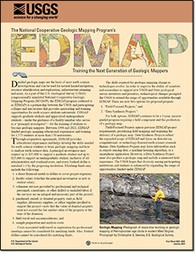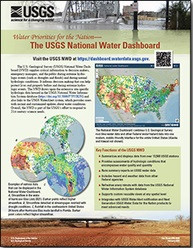
Product Details
- Product Number
- 534267
- Series
- FS-2023-3002
- Scale
- NO SCALE
- Alternate ID
- FS-2023-3002
- Authors
- CHRISTOPHER S SWEZEY
- Version Date
- 01/01/2023
- Countries
- USA
- Media
- WEB ONLY
- Format
- WEB ONLY
Additional Details
- Description
-
The EDMAP Program: Training the Next Generation of Geologic Mappers
Fact Sheet 2023-3002
National Cooperative Geologic Mapping Program
By: Jenna L. Shelton, Christopher S. Swezey, and Michael Marketti
This product is not available for order, it can only be downloaded from here (click on image) or within the Publications Warehouse at https://pubs.er.usgs.gov/publication/fs20233002
For additional information, contact:
National Cooperative Geologic Mapping Program
https://www.usgs.gov/programs/national-cooperative-geologic-mapping-prog ram
U.S. Geological Survey
12201 Sunrise Valley Drive, MS 908
Reston, VA 20192
Introduction
Detailed geologic maps are the basis of most earth science investigations and can be used for natural hazard mitigation, resource identification and exploration, infrastructure planning, and more. As a part of the U.S. Geological Survey (USGS) congressionally mandated National Cooperative Geologic Mapping Program (NCGMP), the EDMAP program (referred to as EDMAP) is a partnership between the USGS and participating colleges and universities that provides mentorship and training opportunities for earth science students nationwide. EDMAP supports graduate students and upper-level undergraduate students—under the guidance of a faculty member who serves as a “principal investigator”—for the training of students to become geologic mappers. Between 1996 and 2021, EDMAP funded geologic mapping educational experiences and training for 1,373 students at more than 170 universities.
- Survey Date
- 2023
- Print Date
- 2023
- Height In Inches
- 11.000
- Length In Inches
- 8.500
- Languages
- English





